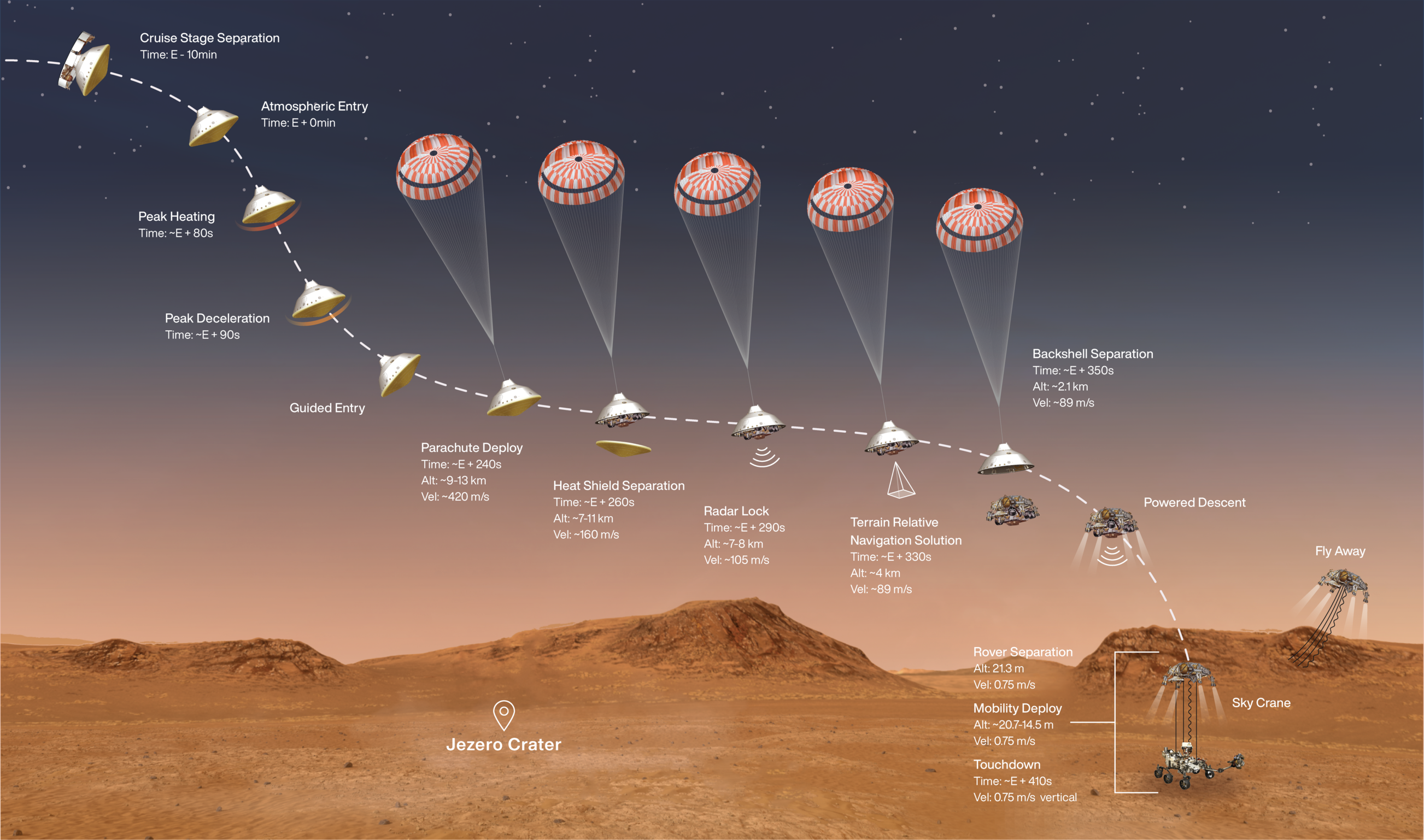
Animation courtesy of NASA/JPL-Caltech
The Perseverance Rover is the centerpiece of NASA's "Mars 2020" mission. Launched on an Atlas rocket on July 30, 2020, the spacecraft reached Mars on February 18, 2021. In order to place the rover safely on the Martian surface, NASA employed a series of techniques, culminating in the nerve-wracking "sky crane". (Click on the image to see a short animation)

Animation courtesy of
NASA/JPL-Caltech
All went well, and the rover was deployed without any damage. The official duration of the rover's mission on the surface is one full Martian year -- 687 Earth days -- or until January 5, 2022.
Gosh, that's just about four months from now!
But wait a moment. That's just the "official" duration. NASA's scientists and engineers hope that the rover will continue to operate long past its nominal lifetime, just as its predecessors did.
Speaking of its predecessors, let's compare the newest rover to other vehicles which have traversed the surface of the Red Planet.
NASA has placed three "models" of mobile explorers on Mars (in addition to several series of stationary probes). Perseverance is the second entry of the "Mars Science Laboratory" model.
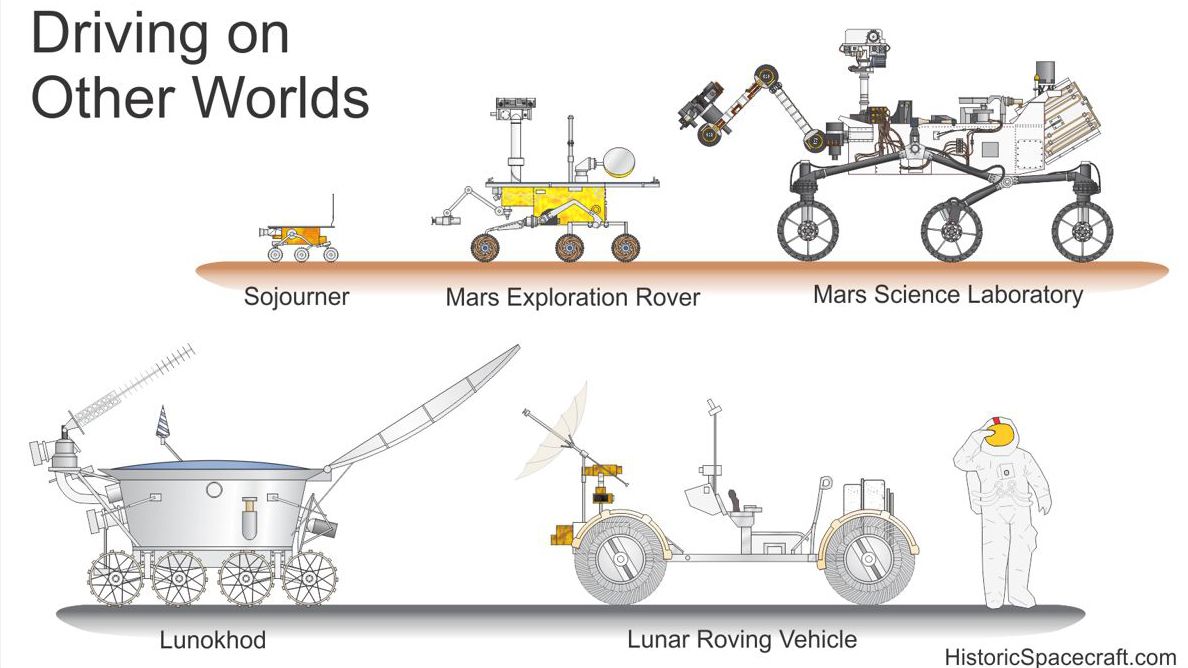
Image courtesy
Historic Spacecraft.com
This family portrait features duplicates of the real rovers which were kept at JPL for testing.
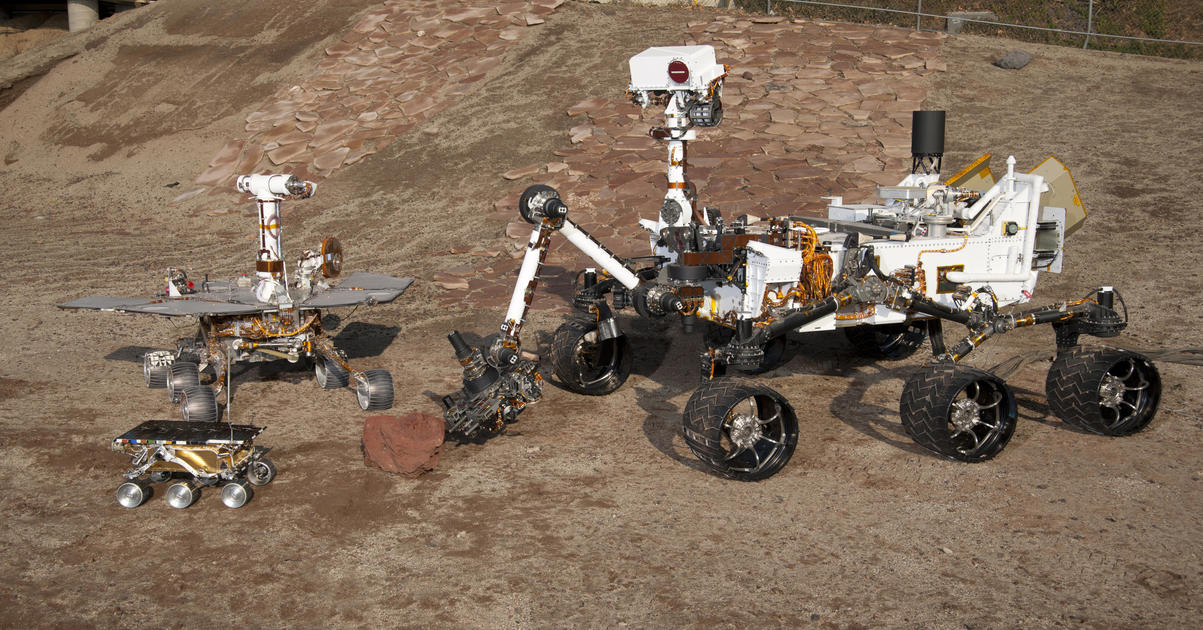
Image courtesy of
NASA/JPL-Caltech
Q: What big obvious feature of the two smaller rovers
is missing from the Mars Science Laboratories?
The smaller rovers were powered by solar panels. The Mars Science Laboratories have their own Radioisotope Thermoelectric Generator (RTG) power source. It contains 4.8 kilograms of plutonium oxide which generates heat via the radioactive decay of Pu atoms. The heat is used to generate electricity, producing about 110 Watts at launch; but the power decays gradually due to the ever-decreasing amount of plutonium in its power source. Even so, the RTG could provide enough electricity to power Perseverance for up to 12 or 13 years after landing.
Perseverance is the younger brother of Curiosity, arriving nine years after its sibling. Despite its youth, it is slightly larger -- 3 meters long, 2.7 meters wide, and 2.2 meters tall -- and more massive -- 1025 kg -- than its near-twin. Its instrument package is also slightly more sophisticated, containing updates such as a pet helicopter.
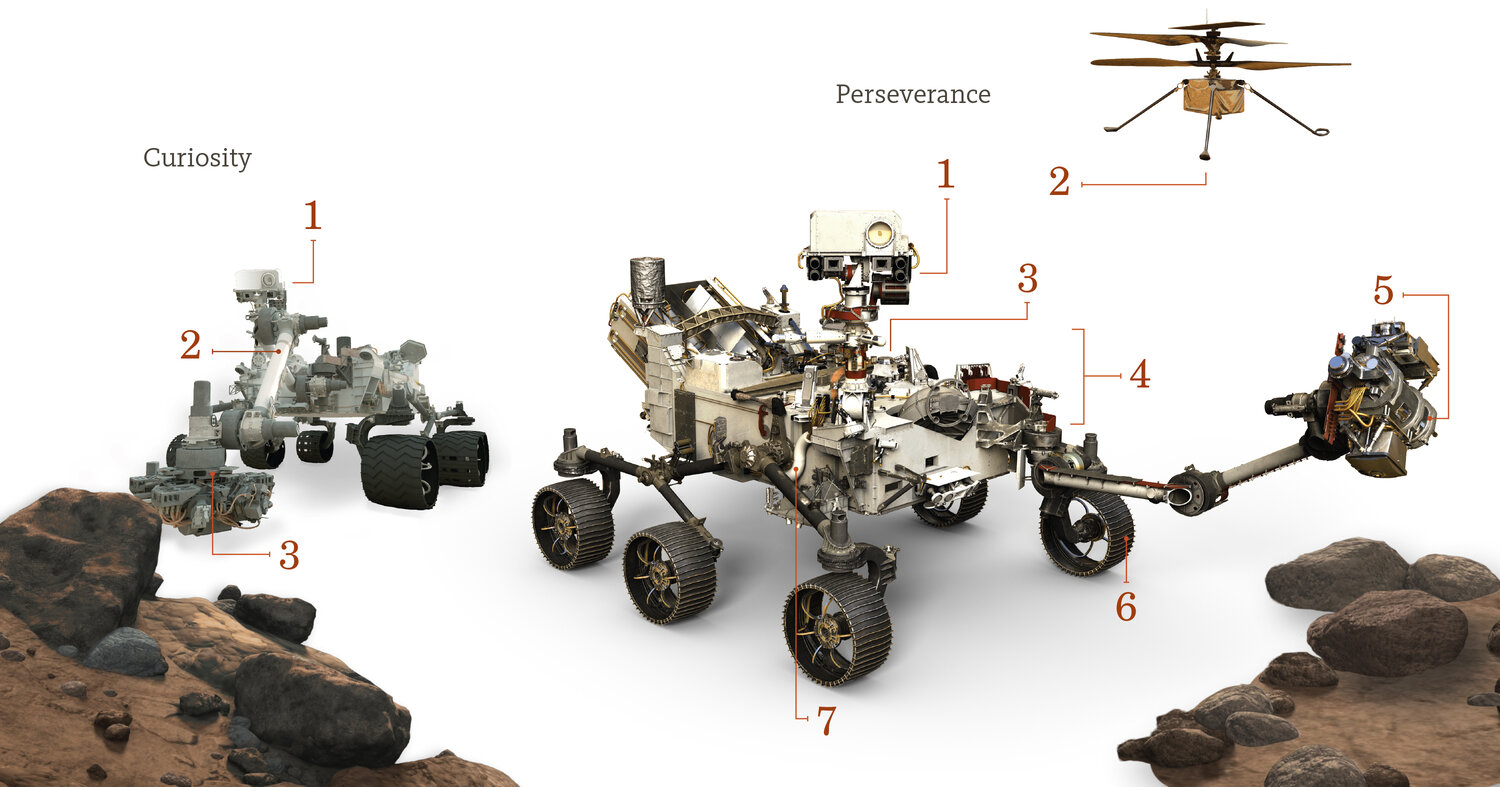
Image courtesy of
Caltech Magazine
We should not forget that Curiosity and Perseverance are NOT the only active vehicles on the Martian surface. China's first mission to Mars successfully placed its own rover, named "Zhurong", onto the landscape on May 22, 2021.
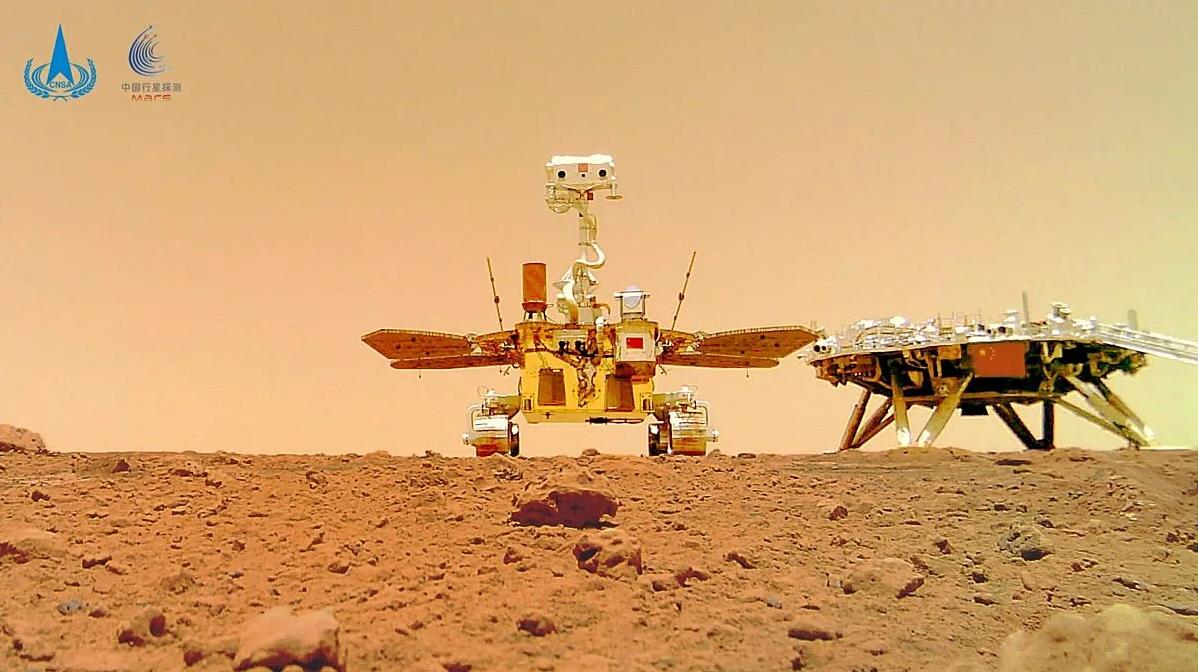
Image courtesy of
Chinese national space agency (CNSA) and Chinese Academy of Sciences (CAS)
Zhurong has continued operating past its nominal mission lifetime, which ended on Aug 15, 2021. In just a week or two, the Sun will pass between Mars and the Earth, interfering with radio communications. Zhurong will put itself in safe mode for five to six weeks, then wake up and continue its work once communications can be re-established.
NASA will also curtail operations during this solar conjunction, but only for about two weeks.
The rover carries a suite of scientific instruments. Some of them are cameras which take pictures of the Martian landscape. Let's see how these "eyes" work.
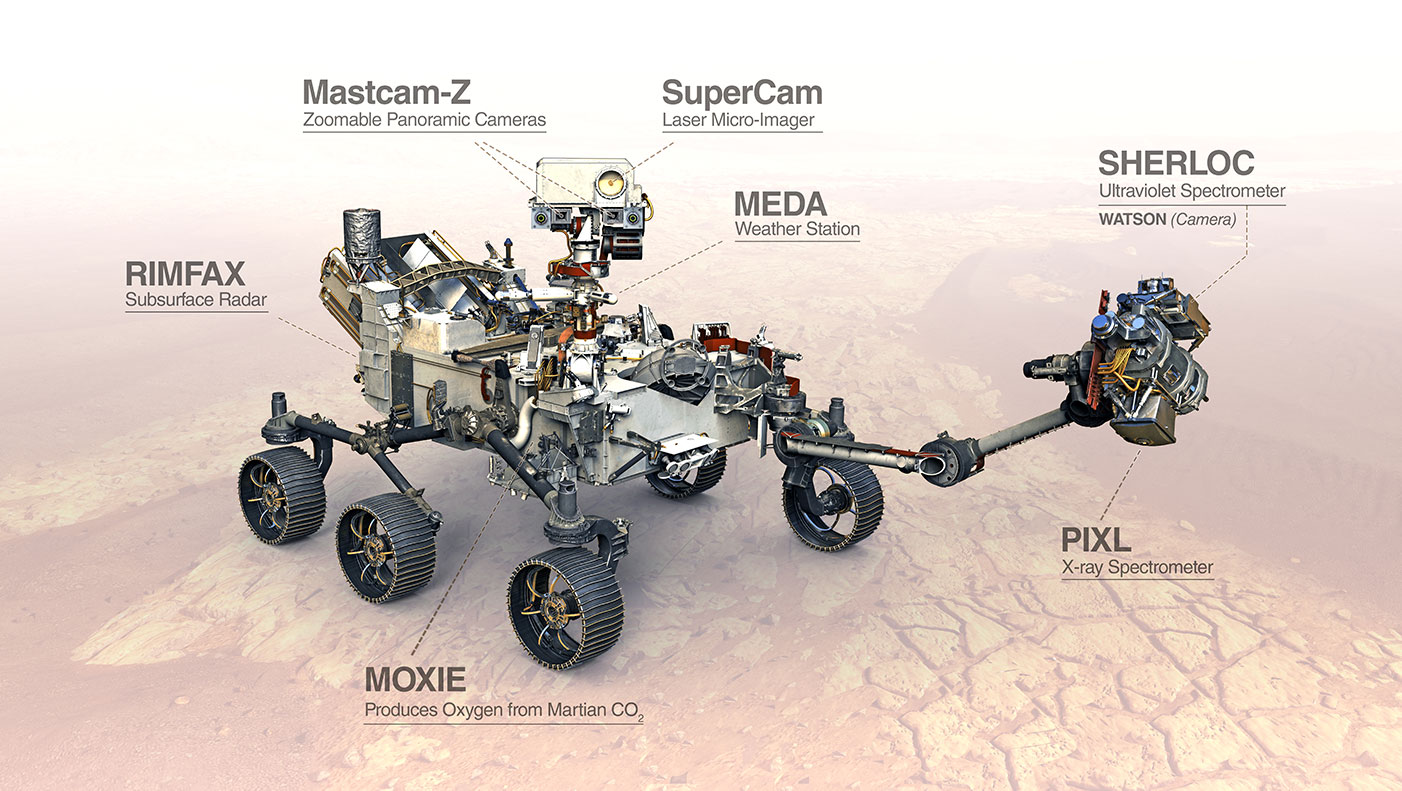
Image courtesy of
NASA JPL/Caltech
The MASTCAM-Z is a pair of cameras, set side-by-side so that they can take stereoscopic pairs. The optics can zoom in on distant objects, or provide very detailed views of nearby features. The unit can also capture short video clips (as you will see in a bit ...)
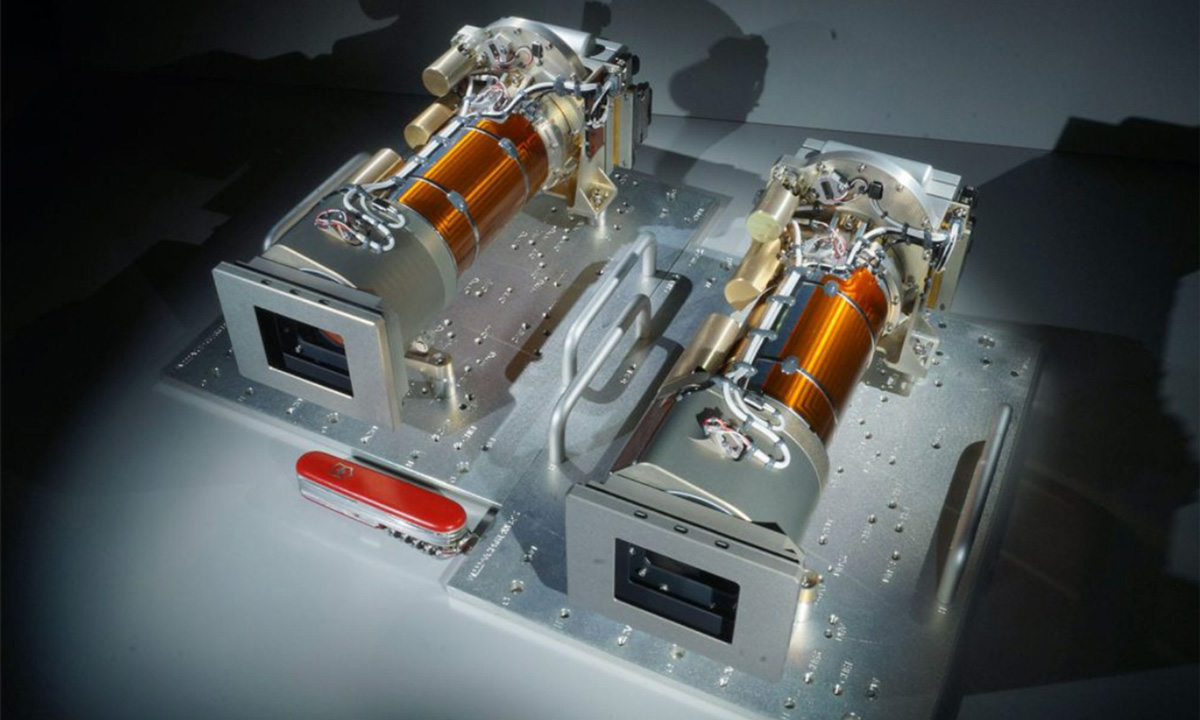
Image courtesy of
MSSS/ASU
Here's a recent example of a mosaic created with MASTCAM-Z. Click on the image for a full-sized version, or visit

Image courtesy of
NASA/JPL-Caltech/ASU/MSSS
Mounted on the robotic arm are a pair of companions who work together: SHERLOC and WATSON. We'll discuss SHERLOC a bit later. WATSON is an optical camera/microscope, designed to take close-up pictures of details as small as 15 micrometers.

Image courtesy of
NASA/JPL-Caltech
Click on the image below to see how WATSON can examine rocks and soil at an intimate scale.
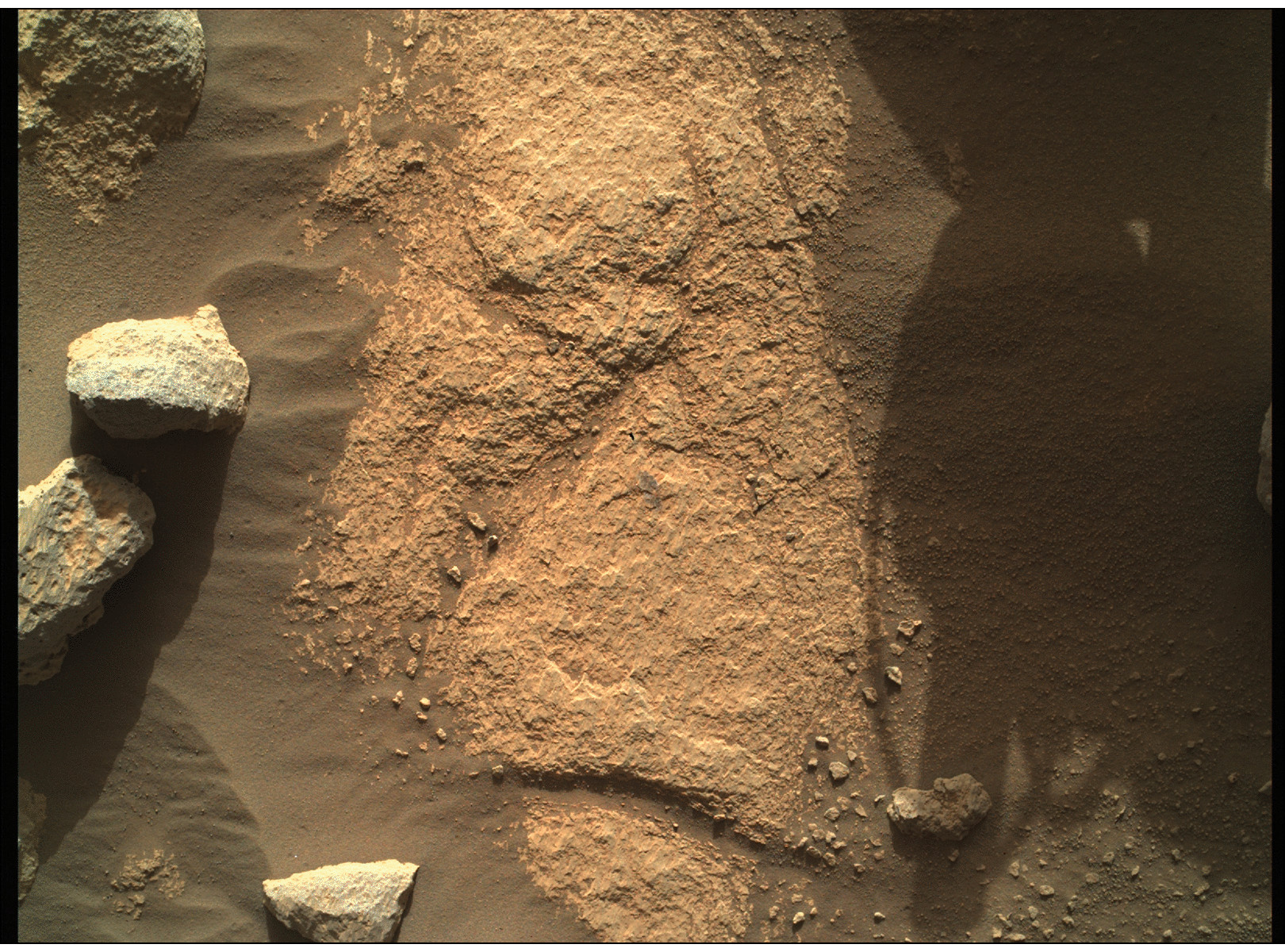
Image courtesy of
NASA/JPL-Caltech/MSSS
Perseverance landed inside a large (45 km in diameter), ancient crater which we call Jezero. Measurements made by spacecraft in orbit suggested that the floor of this crater contained minerals which were formed in liquid water.
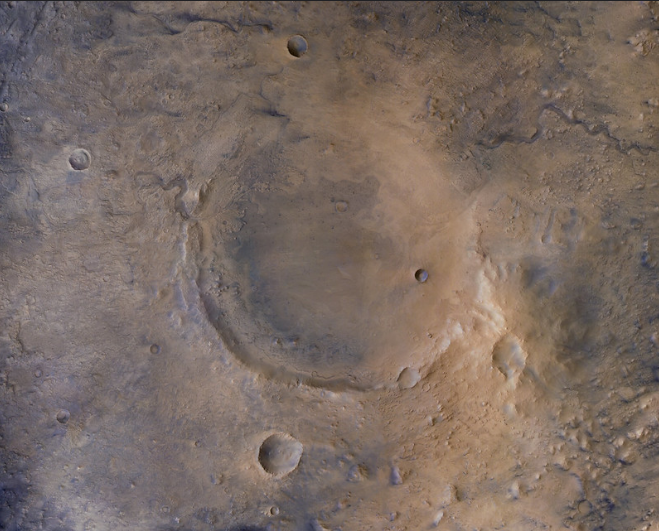
Mosaic of Jezero crater, created by
Justin Cowart
from images provided by
NASA/JPL/MSSS and NASA/JPL/JHUAPL and ESA/DLR/FU Berlin.
If you look closely at the left side of the crater, you can see a break in the rim which looks very much like a channel dug by running water. The floor just inside that channel shows a fan-shaped pattern which also suggests flowing water.
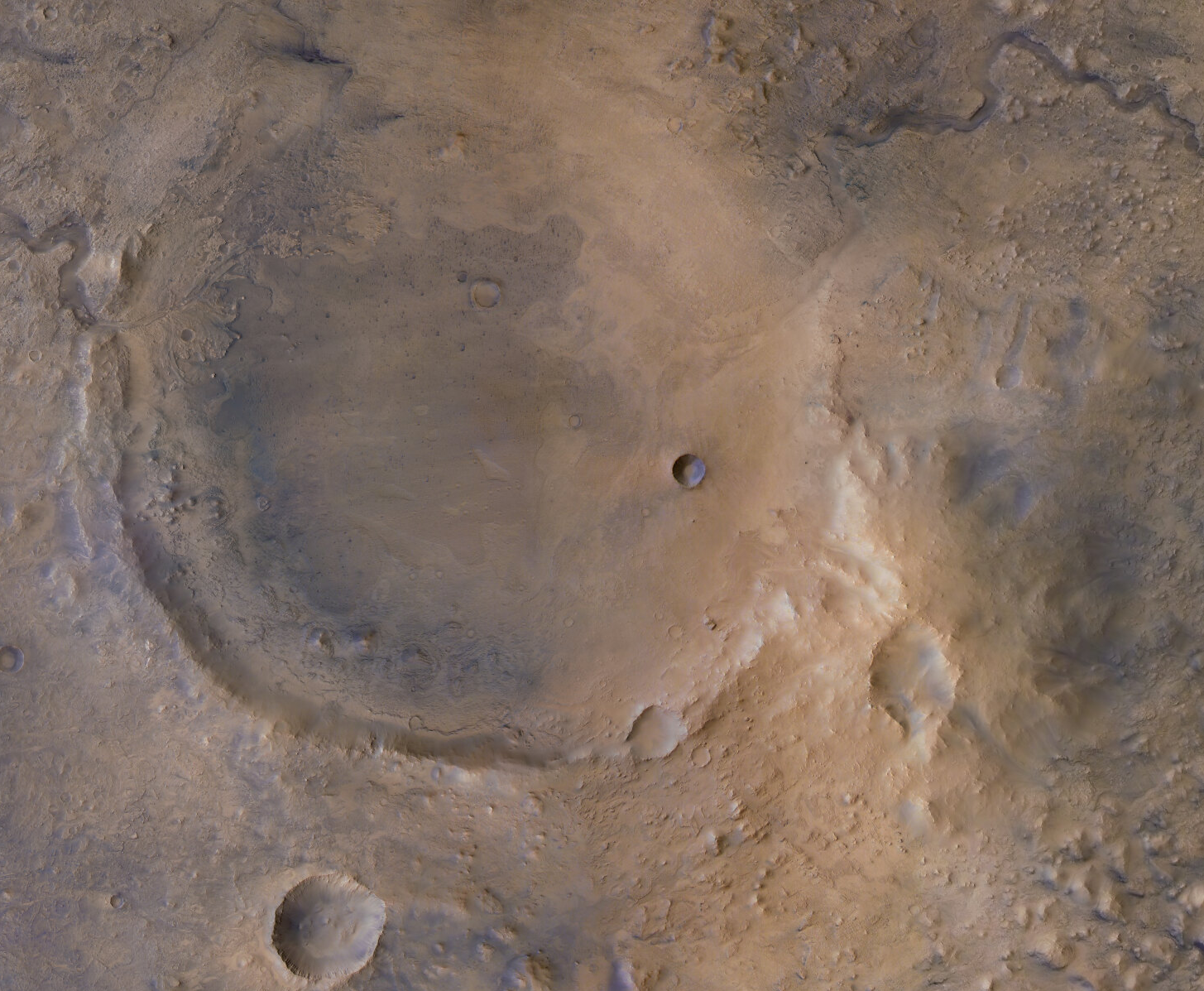
Mosaic of Jezero crater, created by
Justin Cowart
from images provided by
NASA/JPL/MSSS and NASA/JPL/JHUAPL and ESA/DLR/FU Berlin.
NASA chose a landing spot just to the right of this fan-shaped structure, on the safe, flat regions further away from the rim. The rover has been moving toward the fan and channel, trying to get close enough to study them from the the ground. Note the outcrop labelled "Kodiak."
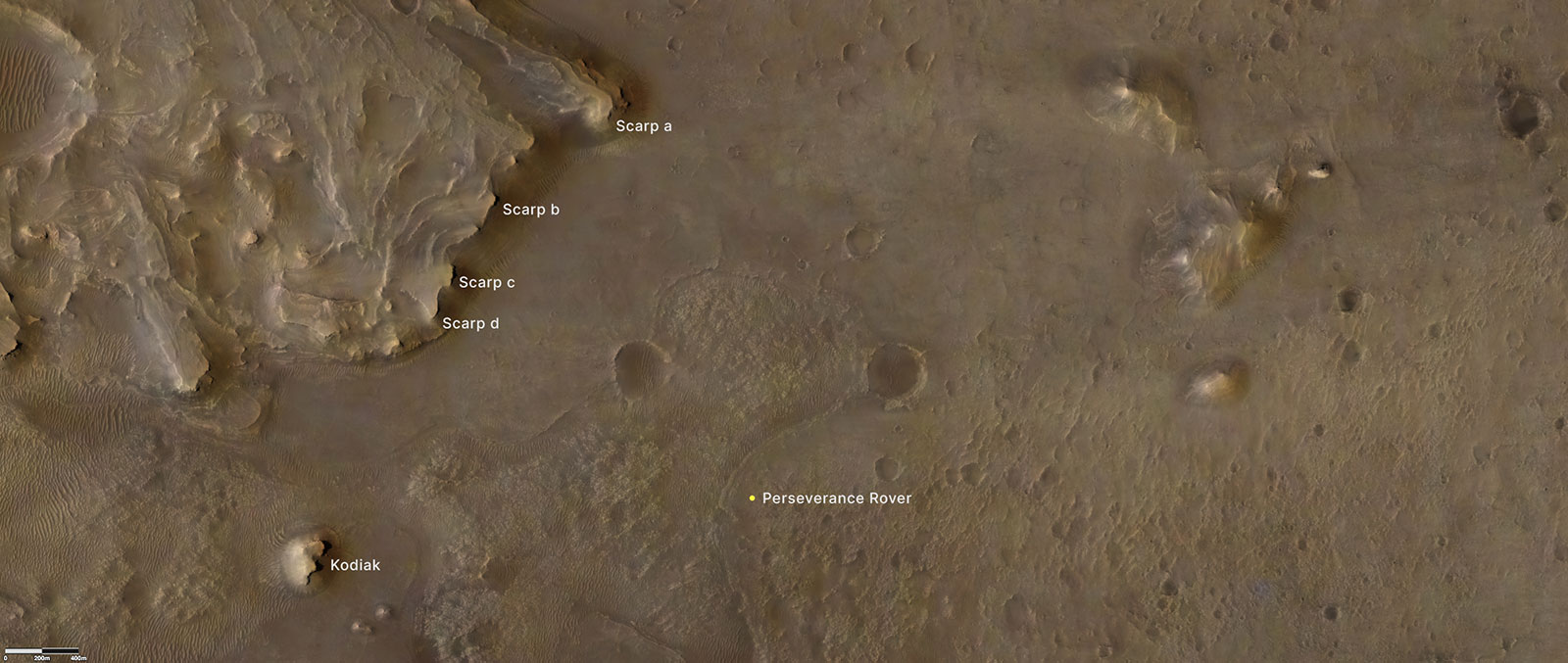
View of Perseverance site from orbit, courtesy of
NASA/JPL-Caltech/University of Arizona/USGS
Pictures taken by MASTCAM-Z of the rocks in "Kodiak" reveal a complex history of this portion of the crater.
The rocks contain a series of layers, built up in three distinct units:
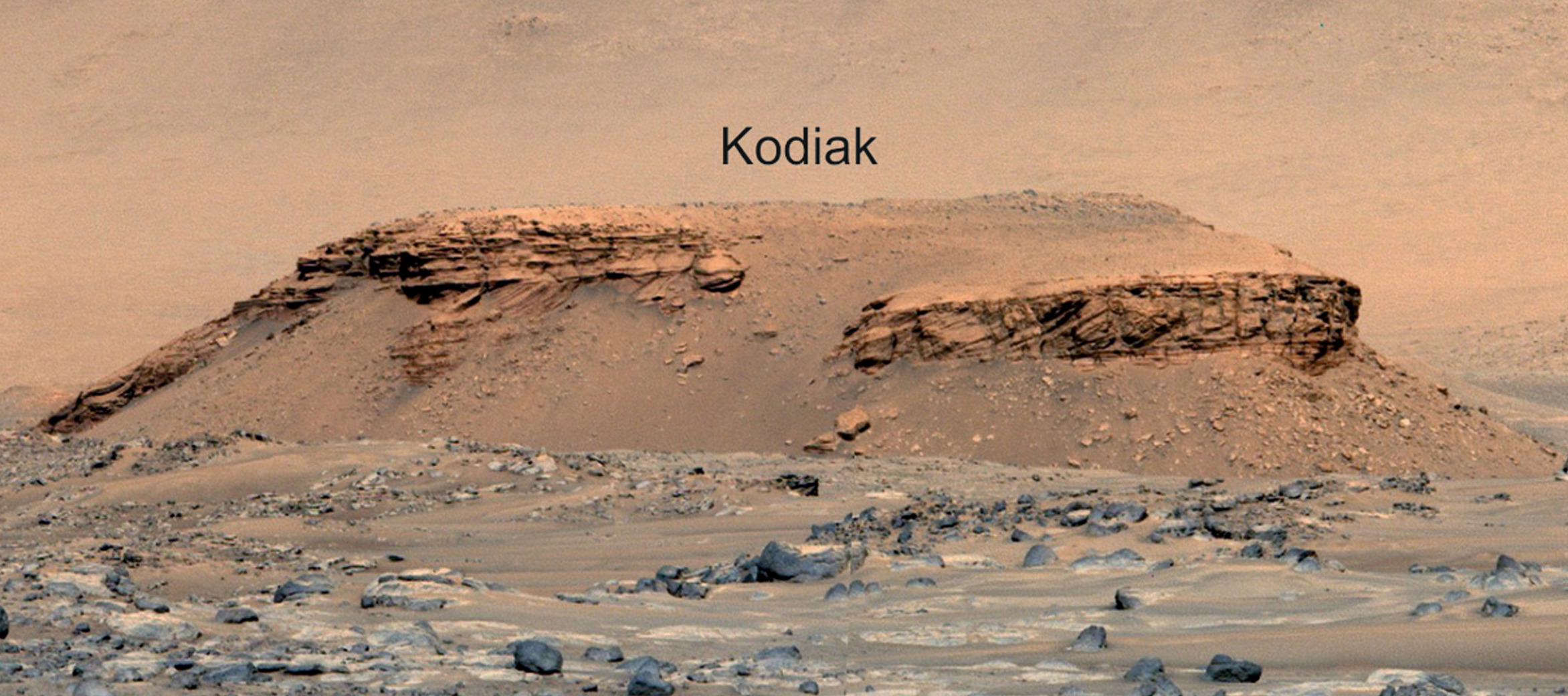
Taken from Figure 1 of
Mangold et al., Science 374, 6568 (2021)
One way to explain this arrangement is that the Jezero Crater was, long ago, full of water. Under ordinary circumstances, sediments settled gently to the floor and created a series of thin, horizontal layers of rock. Some time later, after those layers had formed, inflowing water (from the channel in the rim?) quickly and violently deposited material as it flowed into the crater, creating a delta and a "tongue" of material. As the flowing water pushed the material farther and farther into the lake, the layers formed at an angle: higher near the source, and lower far away.
At some later time, the flow of water stopped, and placid still water covered the area again. Another set of horizontal layers were set down on top of the tilted rocks.
At least, that's my inexpert attempt to translate the geologists' explanations, which you can find in
The important takeaway is that, long ago -- billions of years ago, long before any evidence of multi-cellular life on Earth -- Jezero Crater (and other regions of Mars) was covered in water!
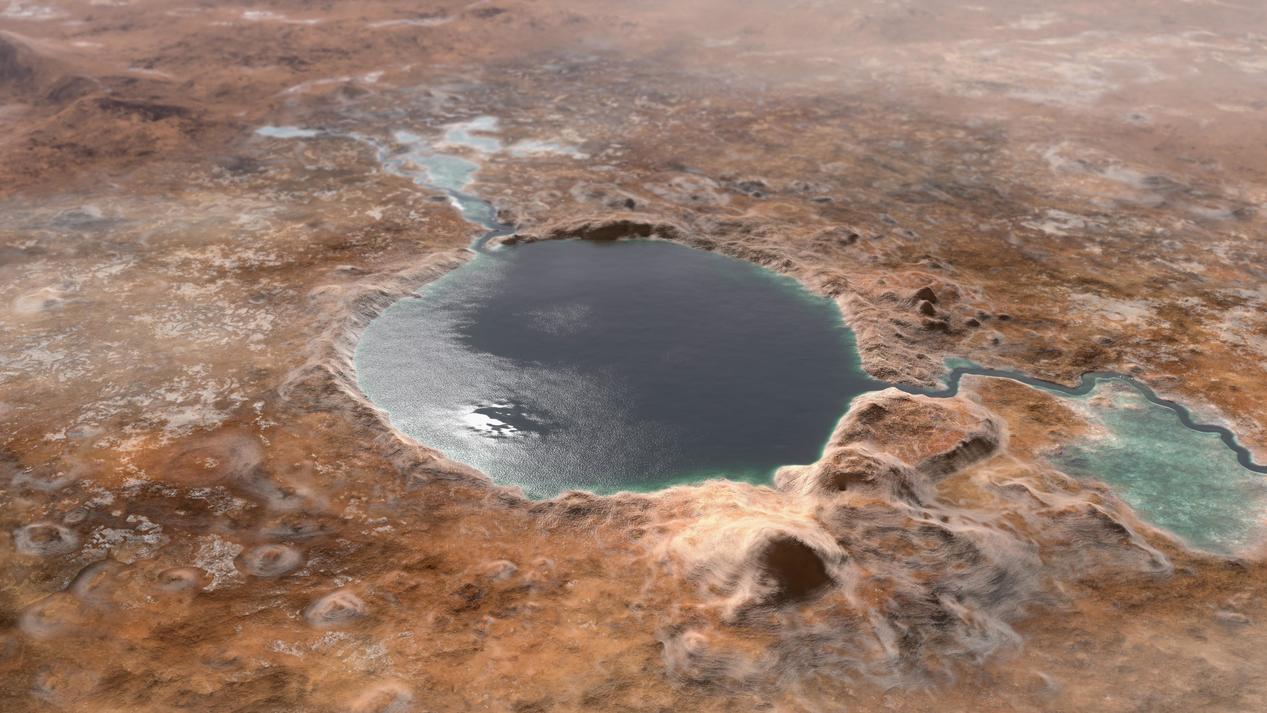
Artist's impression of
Jezero Crater filled with water
courtesy of
NASA/JPL-Caltech
So that was the plan -- but Perseverance has exceeded expectations. Although her nominal mission lifetime was about two Earth years, the rover is still alive and rolling now, almost four Earth years later. It has crawled out of the Jezero crater and is now investigating regions outside:
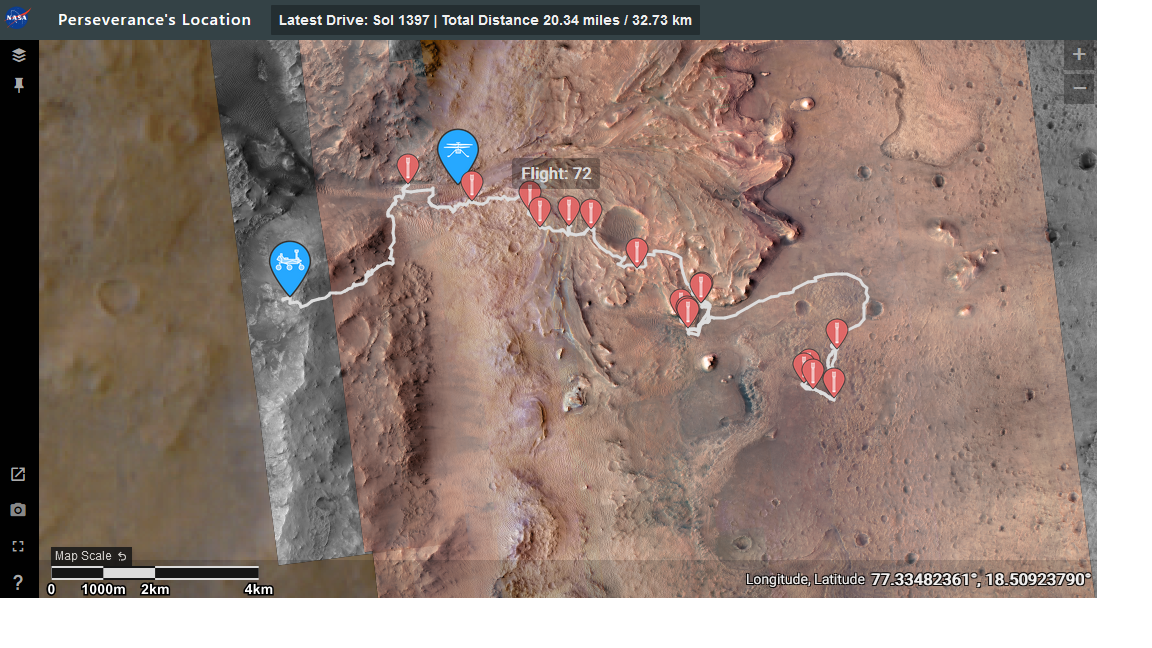
Image courtesy of
NASA/JPL
Just taking pictures of the landscape is fine, but there is a special technique which can reveal much more about the rocks and soil of Mars. If one breaks light up into a rainbow, or spectrum, and very carefully measures exactly how much light some material emits each each wavelength, then one can determine its chemical composition. Scientists of all sorts -- chemists, physicists, astronomers, and biologists -- use spectroscopy to investigate molecules, metal surfaces, trees, gas clouds, stars and galaxies, and many other objects.
Perseverance carries (at least) three types of spectrograph on its journey across Mars. Let's discuss each one briefly.

Image courtesy of
NASA JPL/Caltech
Out at the end of the robotic arm sit two instruments which measure spectra. One of them is SHERLOC (Scanning Habitable Environments with Raman & Luminescence for Organics & Chemicals). which shines an ultraviolet laser beam at rocks or soil. It then measures the spectrum of the light which either bounces off the surface, or is later radiated away as molecules excited by the laser gradually lose their energy.
Mounted on the opposite side of the robot arm is PIXL (Planetary Instrument for X-ray Lithochemistry), which bombards samples of soil or rocks with X-rays. When atoms in the material are excited by the X-rays, they emit radiation in response -- and each material emits a different pattern of X-rays. PIXL uses the pattern of radiation to identify the elements present in the material.
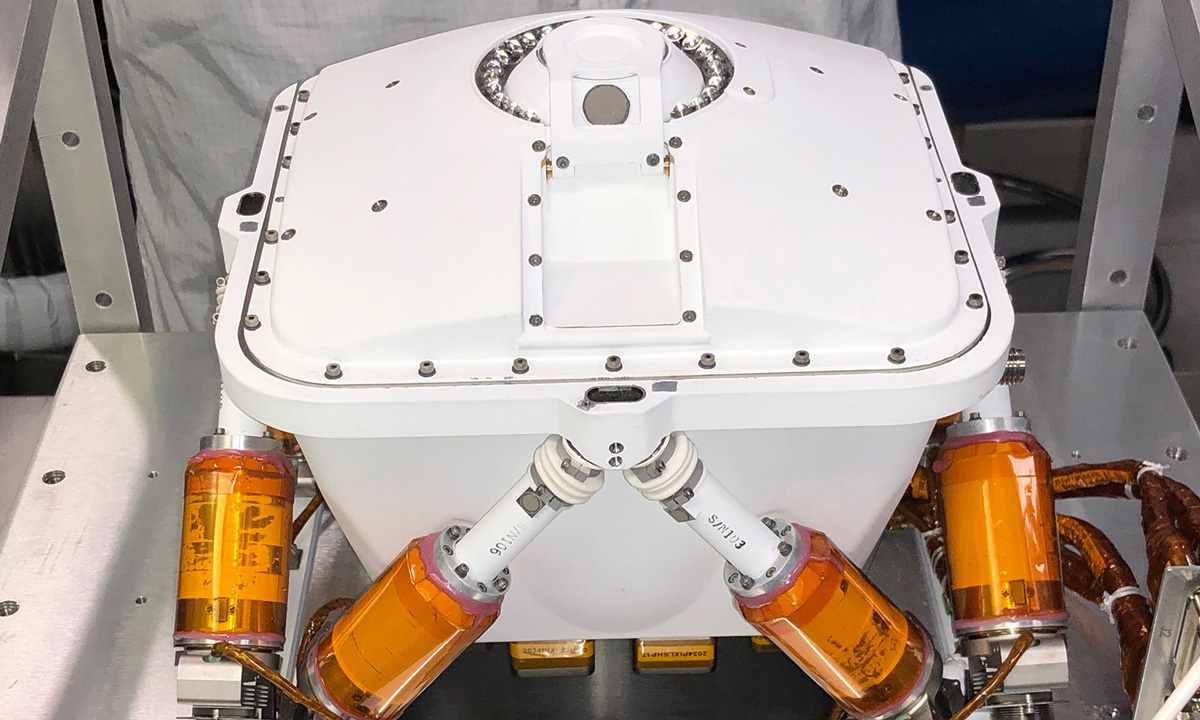
Image courtesy of
NASA/JPL-Caltech
Below are some results of one of PIXL's first scans.
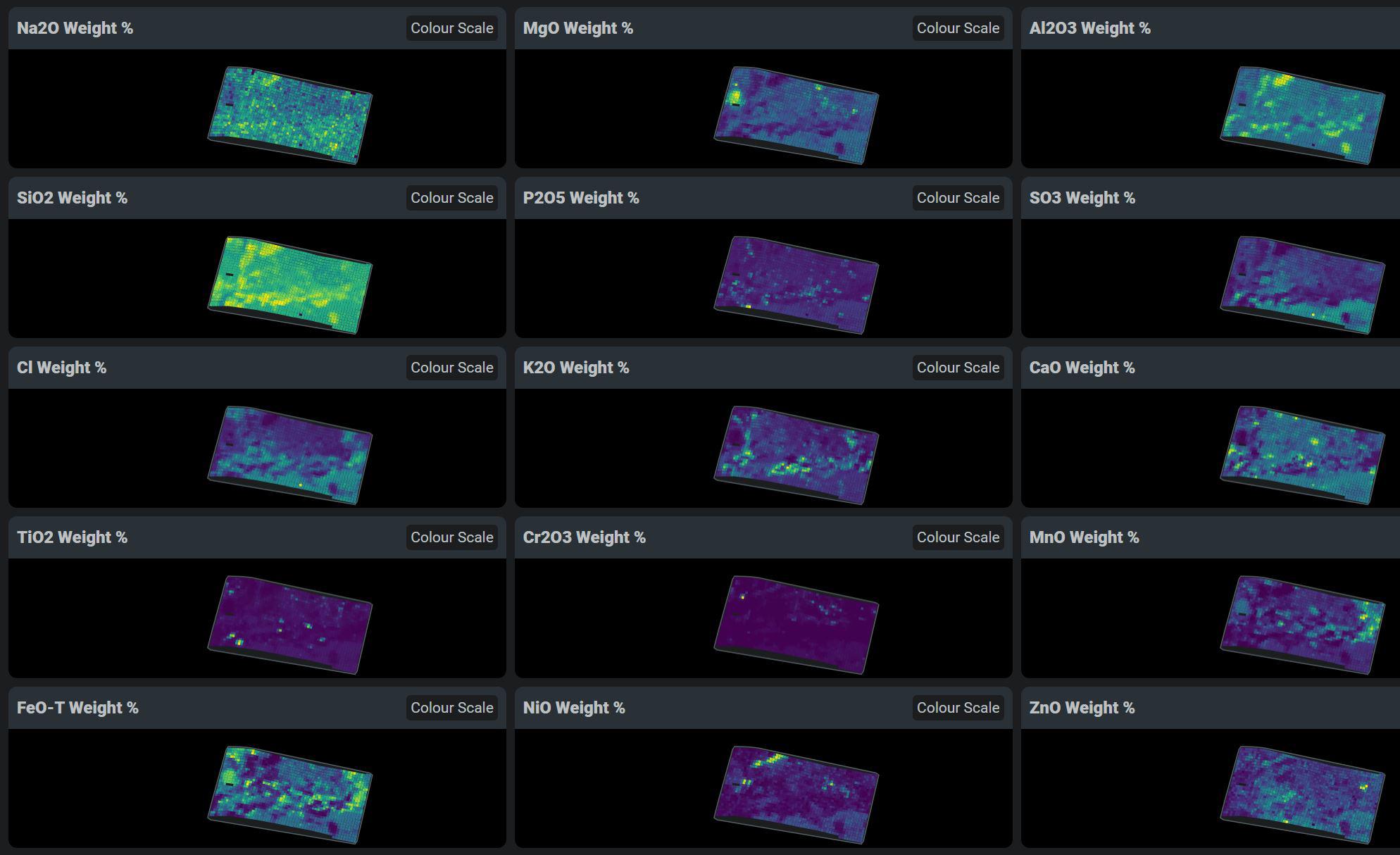
Image courtesy of
NASA/JPL-Caltech
One of the rocks measured by PIXL contained crystals of salt minerals, shown as the yellow patches in the close-up below. Those minerals very likely formed as the water in Jezero Crater dried up, and might have trapped tiny samples of the water.

Image courtesy of
NASA/JPL/Caltech/DTU/UW/QUT
The final instrument we'll discuss is SUPERCAM, which sits on top of the main mast, next to MASTCAM-Z. SUPERCAM uses several cameras, spectrometers, and a laser, all working together, to measure the chemical properties of rocks and soil. Using its laser, it can vaporize small samples of material, then measure the light emitted by the hot gas and identify its elemental composition by the spectroscopic signatures. Unlike PIXL and SHERLOC, which must be placed next to their subjects by the robotic arm, SUPERCAM can investigate objects which are beyond Perseverance's reach.
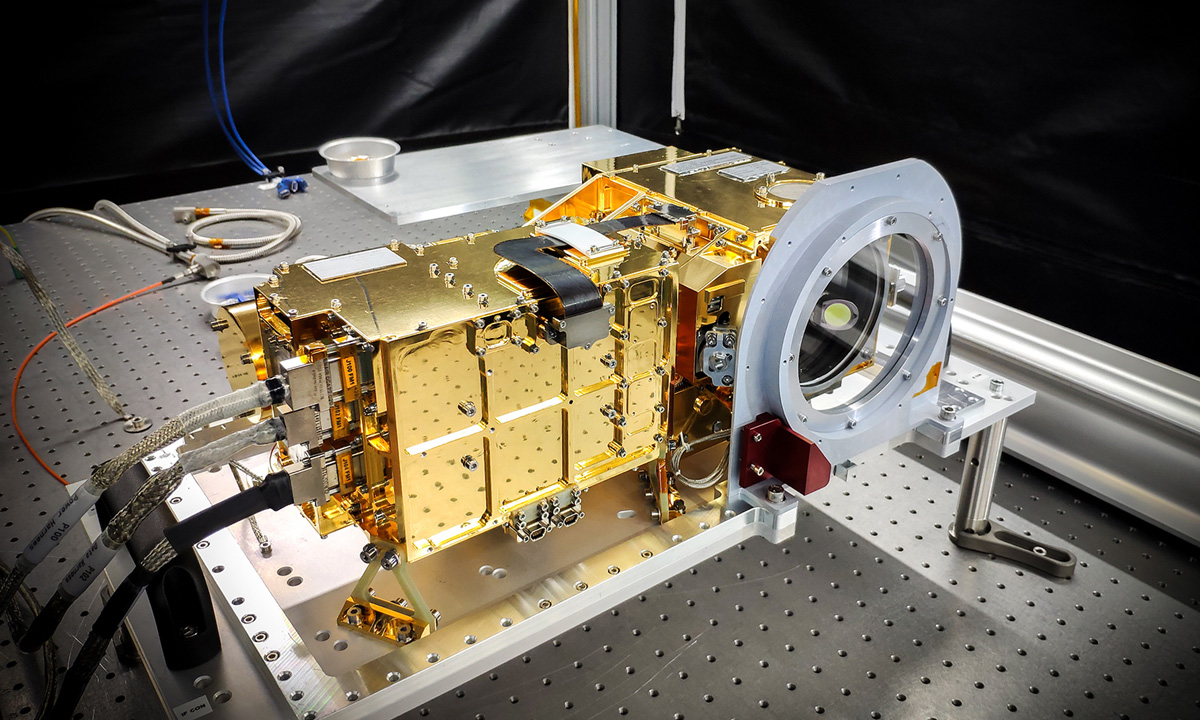
Image courtesy of
NASA/JPL-Caltech
But sometimes, even these three instruments can't tell us everything we want to know about the rocks and minerals in Jezero Crater. Scientists have more sophisticated and capable instruments in their labs back on Earth, where they could crush and grind and dissolve and test the rocks to their hearts' content. If only there were some way to bring the rocks ... back to Earth.
Perseverance differs from its sibling in one VERY important respect: it has a new and special mission goal. It will play the first part of a complicated procedure that will, eventually, return samples of Martian rocks and soil to the Earth, where scientists might examine them directly! The basic idea goes like this ...
Step 1 (2021-2023?): Perseverance collects samples of material and seals them into titanium tubes. It carries the tubes to one (or more) "drop zones", then leaves them on the ground.
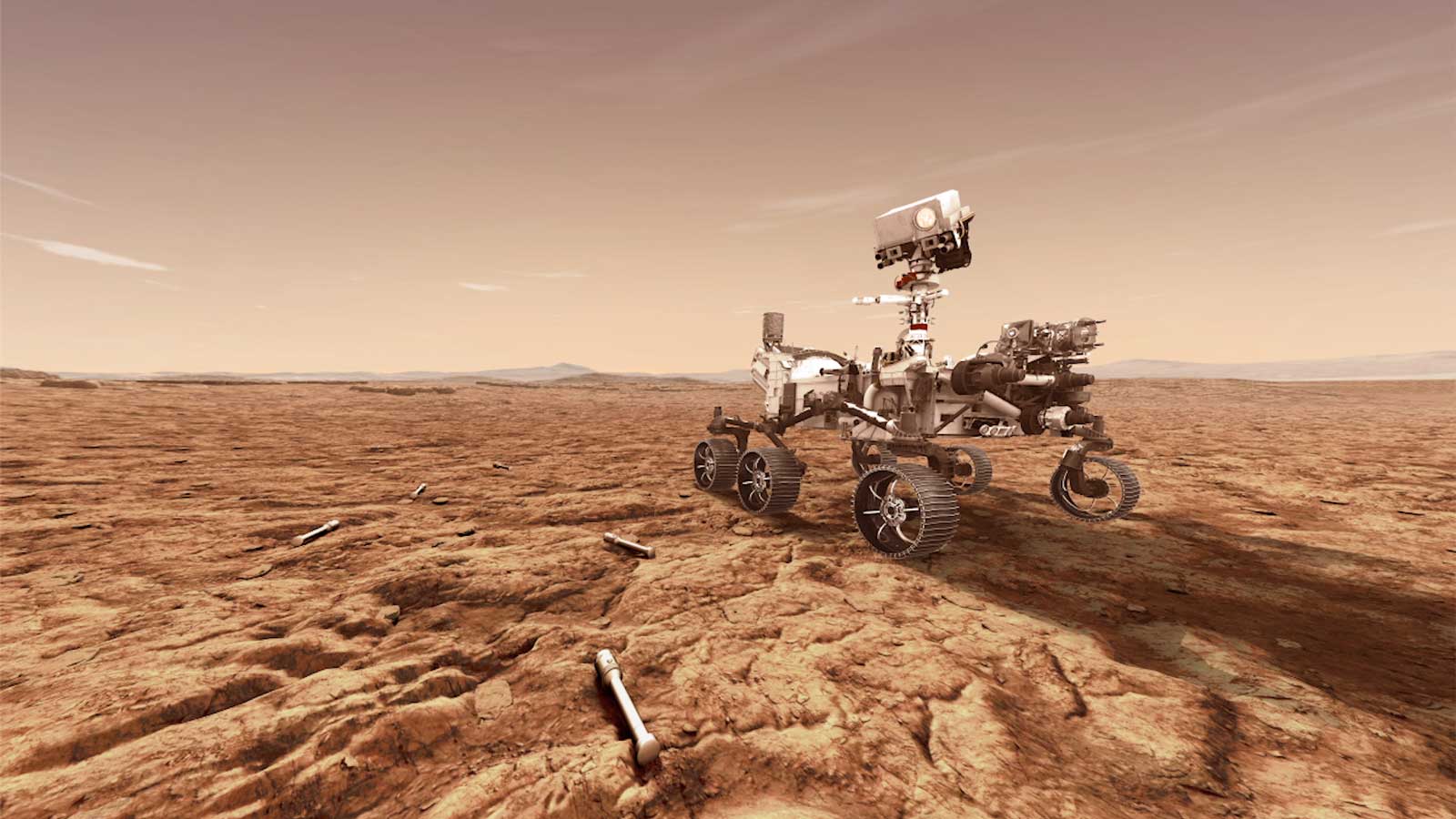
Image courtesy of
NASA/JPL-Caltech
Step 2 (2028?): A second NASA/ESA mission, the Sample Return Rover, drives around to pick up the tubes.
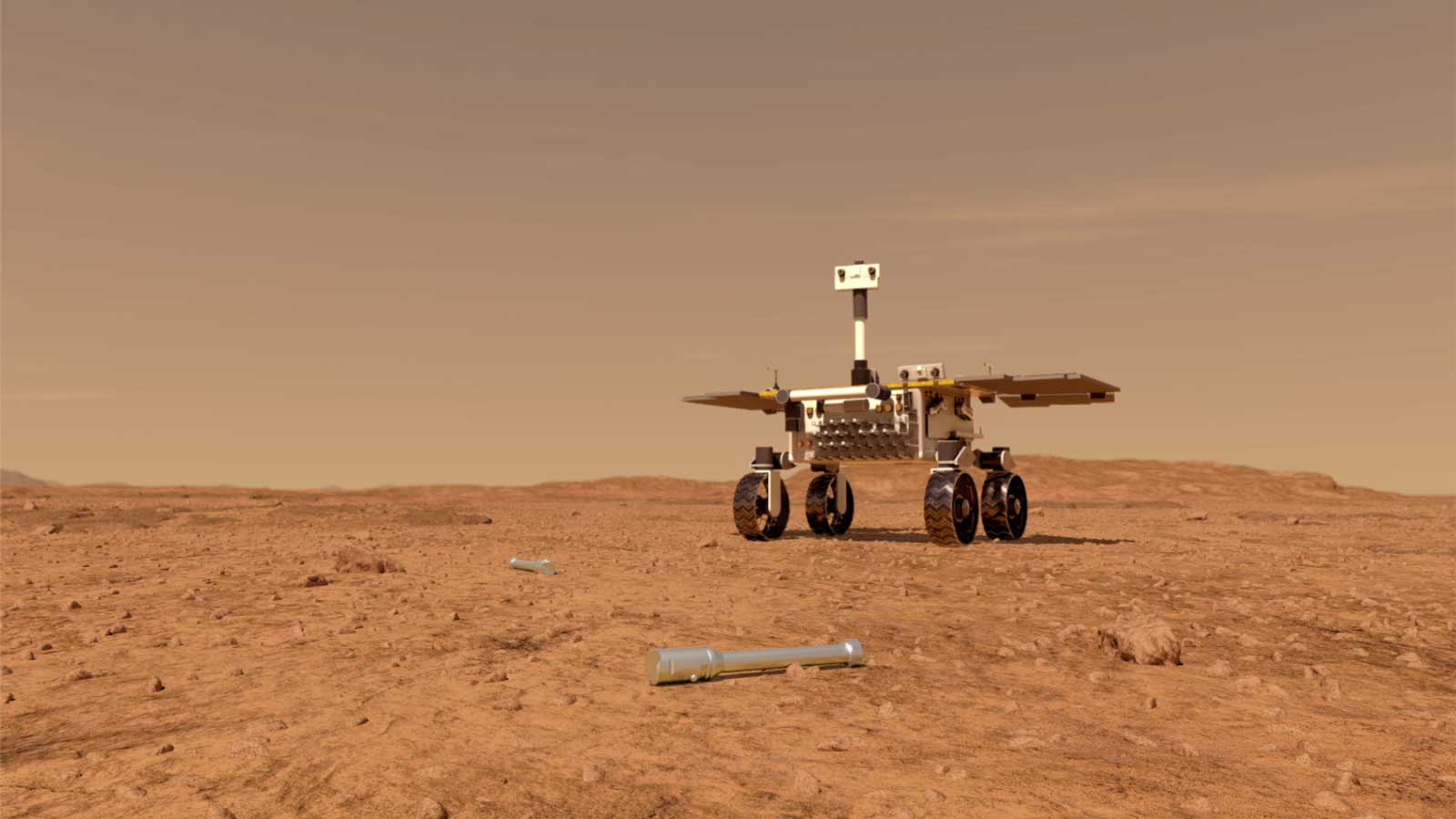
Image courtesy of
NASA/JPL-Caltech
Step 3 (2028?): The Sample Return Rover brings all the tubes to its parent, the the Sample Return Lander.
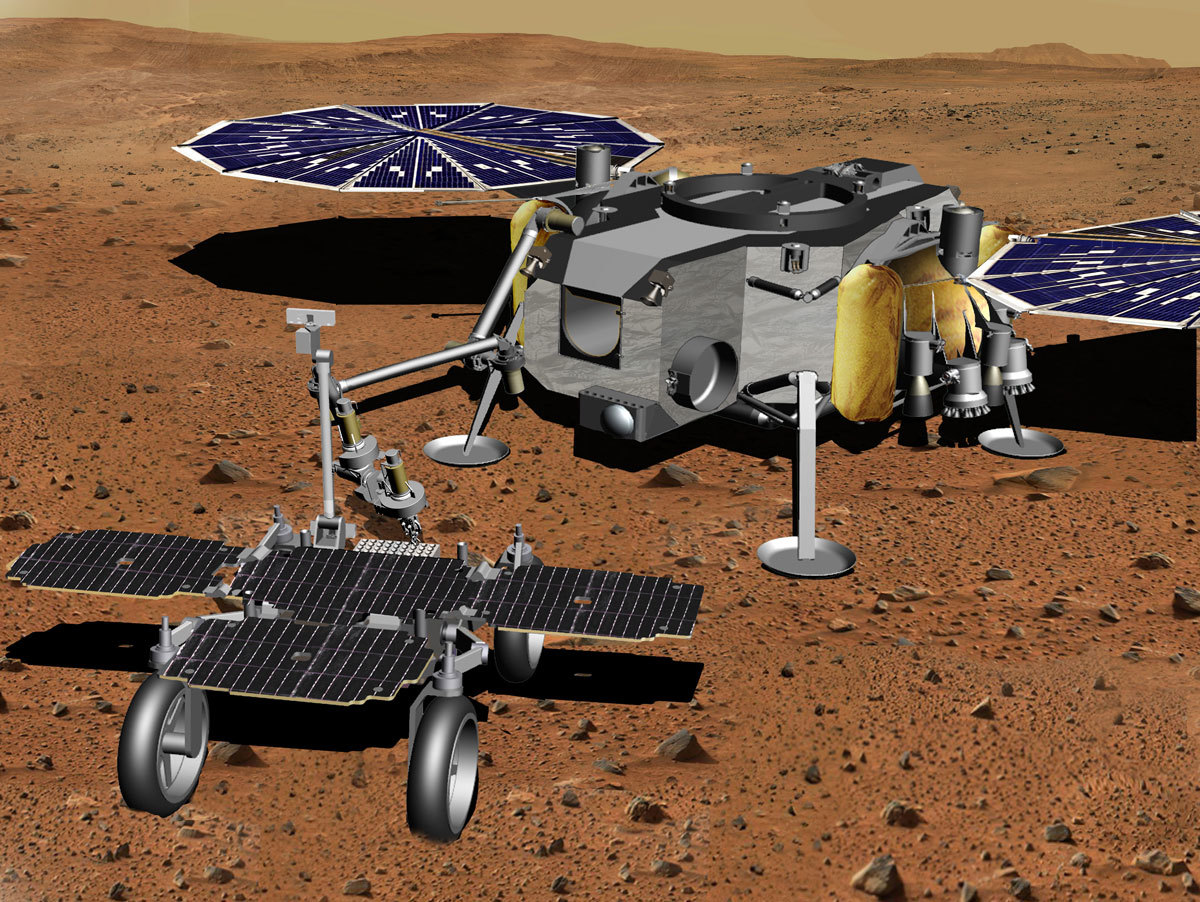
Image courtesy of
NASA/JPL-Caltech
Step 5 (2028? 2029?): The Sample Return Lander places all the tubes into a small rocket and fires it into a low orbit around Mars.
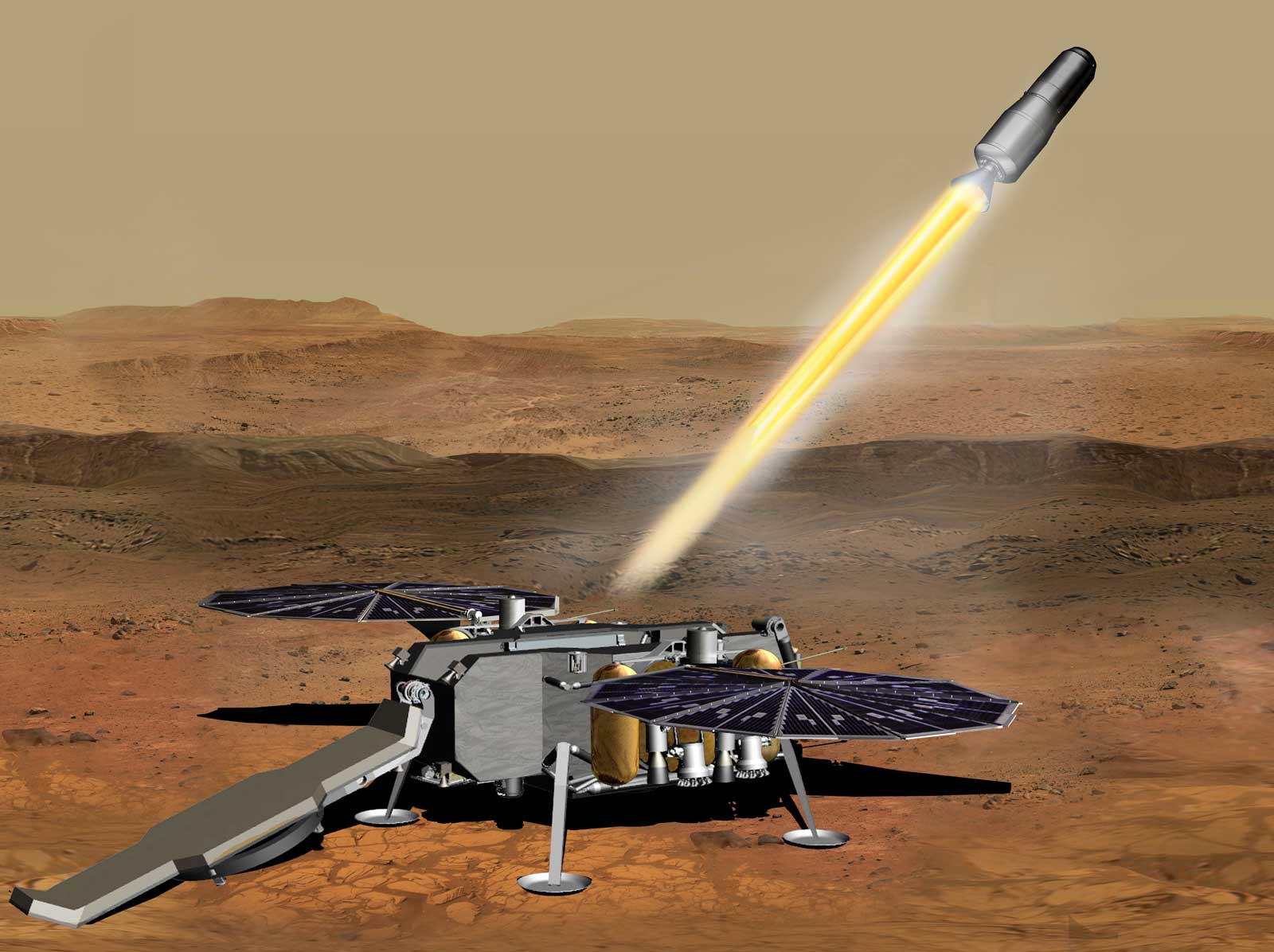
Image courtesy of
NASA/JPL-Caltech
Step 6 (2028? 2029?): The rocket releases its payload into orbit around Mars. It has just enough fuel to push itself away into a slightly different orbit for safety.
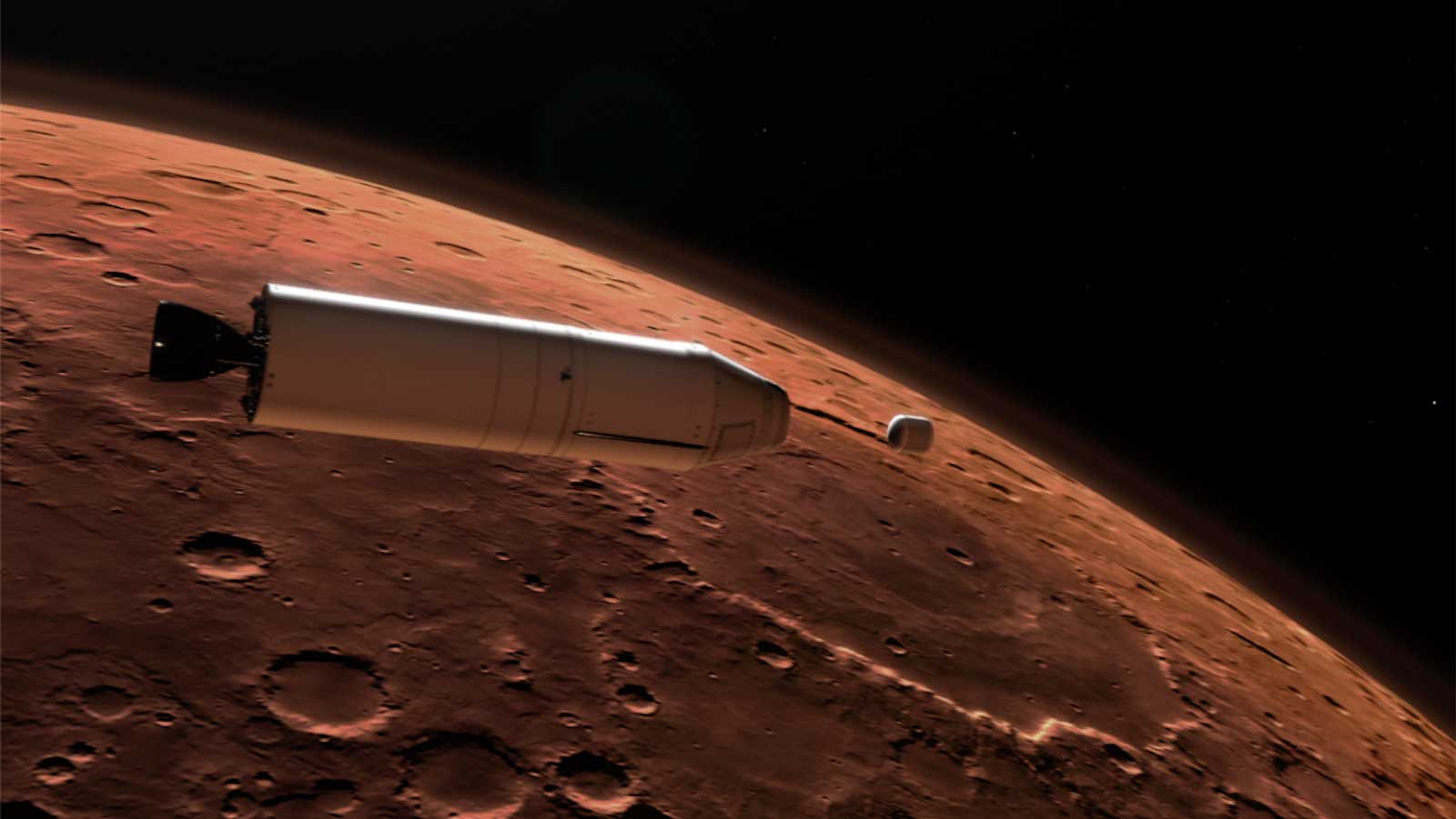
Image courtesy of
NASA/JPL-Caltech
Step 7 (2028? 2029?): A third mission, launched by the ESA, matches orbits with the samples in orbit. It grabs the samples, stows them away, and fires its engines for a return to the Earth.
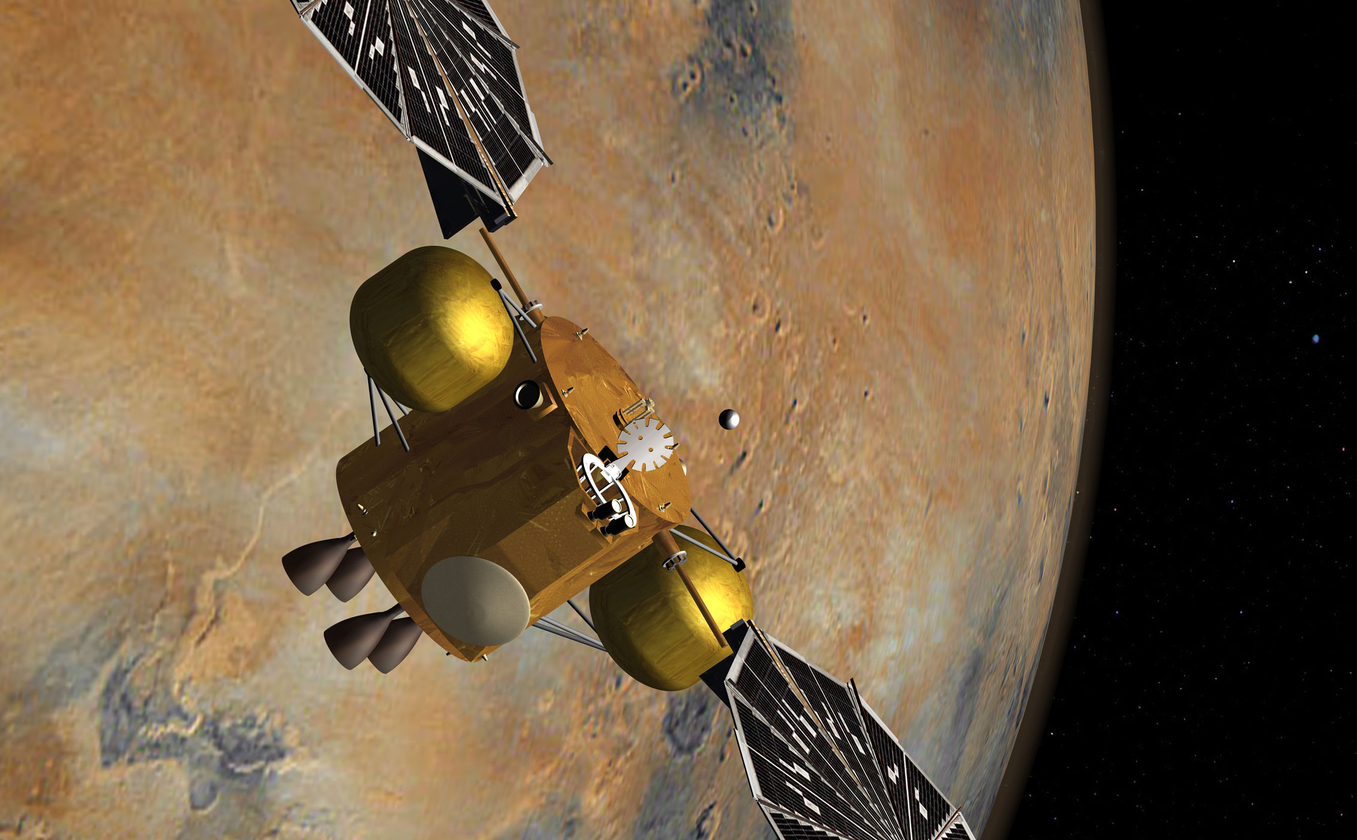
Image courtesy of
NASA/JPL-Caltech
Step 8 (2031?): When the returning spacecraft reaches the Earth, it releases its payload containing the samples in their tubes. The payload (somehow) safely de-orbits and is recovered by NASA.
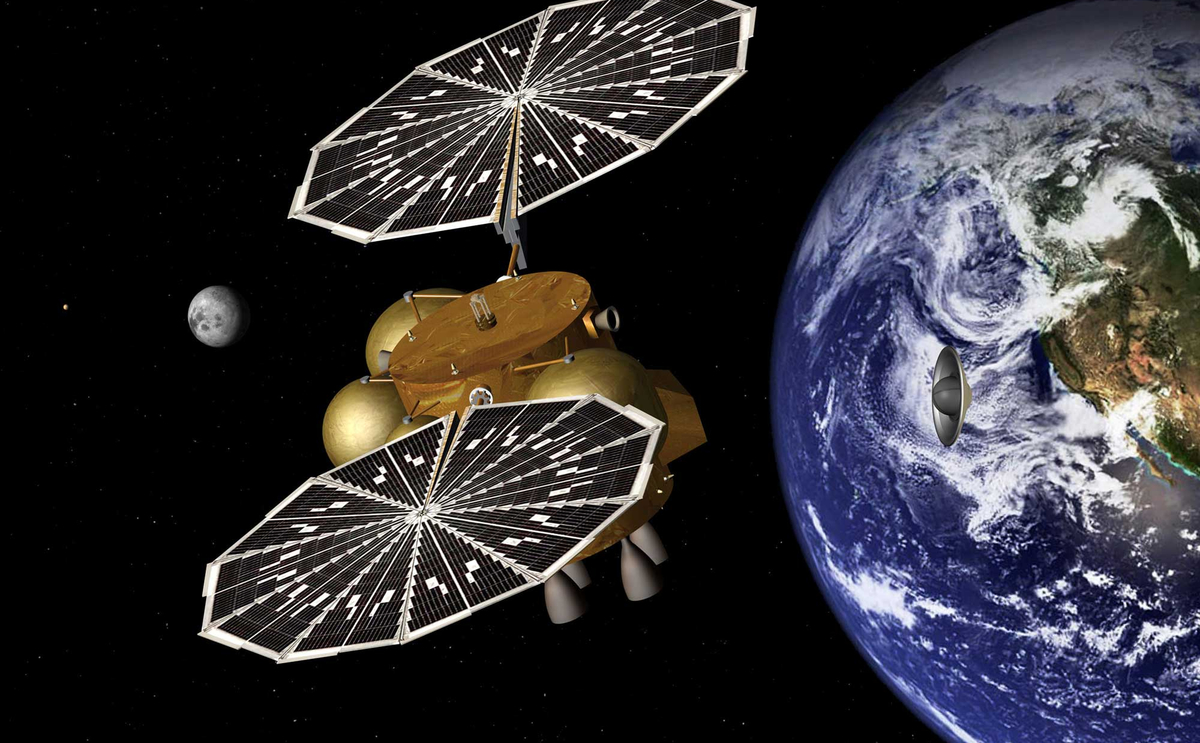
Image courtesy of
NASA/JPL-Caltech
As you can see, this is a VERY complicated process, requiring the cooperation of three different spacecraft. It will take quite some time --- at least ten years from the first sample collection to the eventual delivery to scientists on Earth.
And, speaking of returning samples to Earth, Perseverance just recently collected its first sample of Martian soil! On August 22, 2021, scientists decided to make this rock, nicknamed "Rochette", the target of their second attempt (an earlier drilling operation ended in failure when the soft rock turned into powder and slipped out the drillshaft).
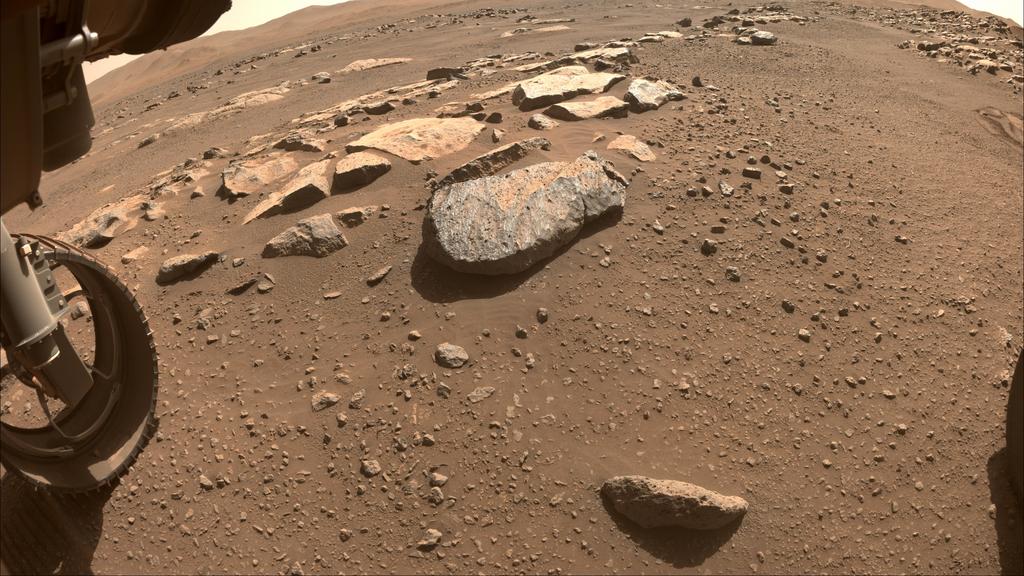
Image courtesy of
NASA JPL/Caltech and
Astronomy Picture of the Day
On Sept 6 and 8, 2021, Perseverance drilled holes in the rock and collected material successfully. (Click on the image to see a short animation, which should start at 10:06 in a longer movie).
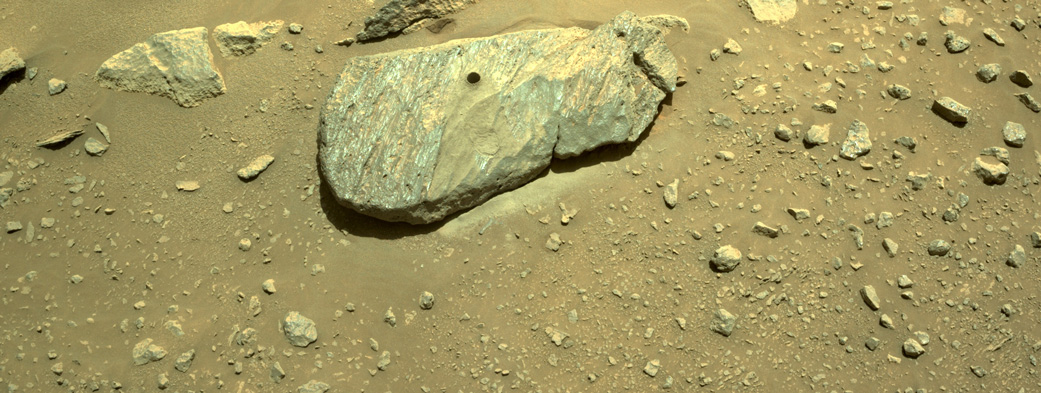
Image courtesy of
NASA JPL/Caltech
Closeups of the cylinder show that it does contain soil.
Hooray! Step 1 has begun!
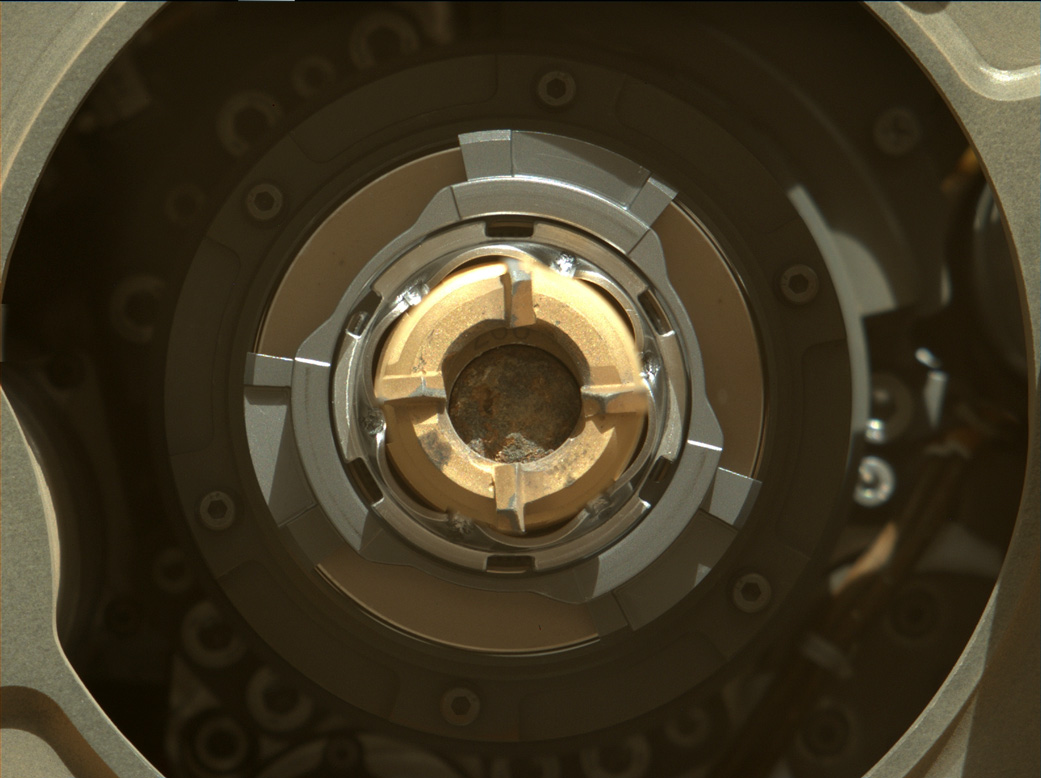
Image courtesy of
NASA JPL/Caltech
And now, in Jan 2025, the rover has collected more samples. It has placed a set of 9 tubes, with material from nine different locations, into a small area for later pickup:
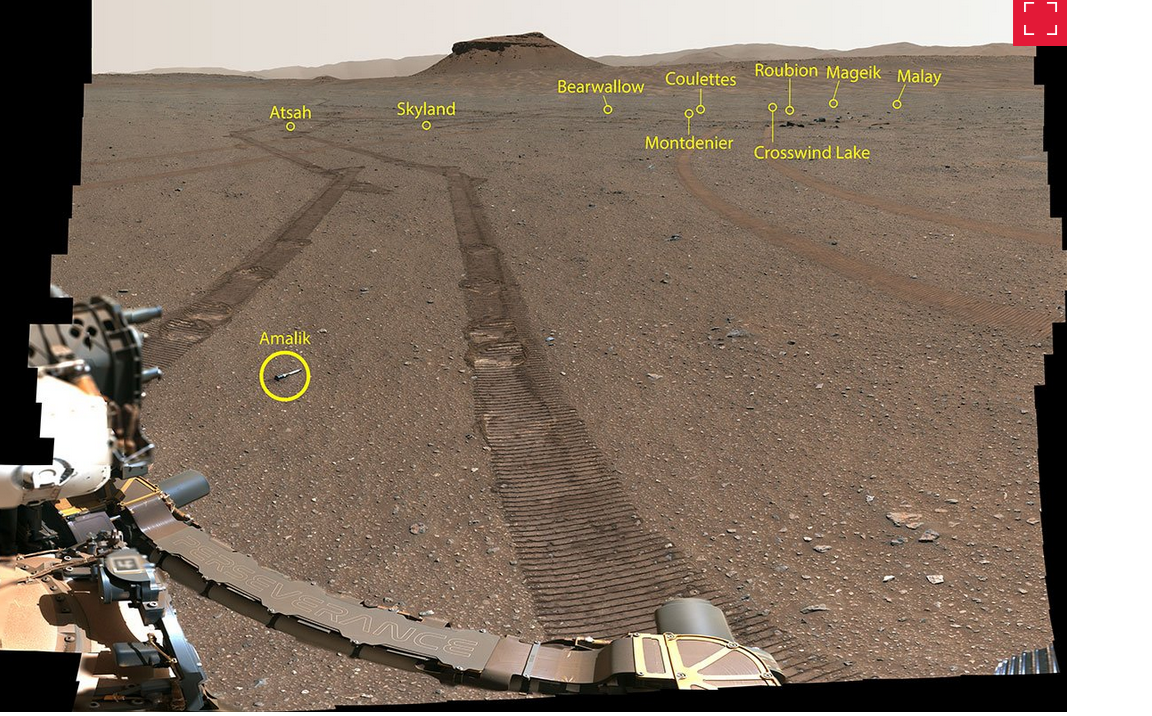
Image courtesy of
NASA/JPL-Caltech/ASU/MSSS